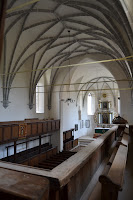This summer we had a week-long wander around Transylvania, first to the forts and fortified churches in the centre of the region, and then making our way west to the Dacian ruins.
The weather was fantastic as we started out in Prahova valley,
making our way north to Rasnov Citadel. We had a walk inside the citadel walls and ate icecream, and then moved on to Rupea Castle.
This was unfortunately closed for repairs, which was a real shame. It is a
very old castle, first built as a Dacian fortress, then a Roman fort,
then a medieval castle, which is all reflected in the walls added from
one period to the next.
Just before closing time, as the keeper was heading home, we made it to Saschiz, one of the UNESCO World Heritage fortified churches. I think we tested the keeper's patience a bit by exploring every single corner including the attic.
And then we finally made it to the campsite. A wonderful campsite, small, quiet, cozy, and very international, kept by a lovely Dutch couple, probably the best campsite I ever stayed in. They even organised a meal for us with neighbours who have a small farm, and who were nice enough to walk us through their garden, orchard, and show us some of the animals. Including this very cute Romanian Shepherd puppy.
The next day we spent some time at Biertan, another fortified church.
And then made our way to Sighisoara, a city with a very well-preserved medieval city centre.
Next day's travels took us westwards to Medias (an old town centre not as well maintained as most other towns we saw, but getting there), Blaj (which used to be an important patriotic and religious centre), and finally Alba-Iulia.
The fort in Alba-Iulia is very impressive. It is absolutely massive and contains a 13th century Catholic Cathedral as well as the Transylvanian centre of the Romanian Orthodox Church, Roman fortification ruins, a lot of old romantic buildings, and a few very pleasant cafes and restaurants.
And that evening we were finally at our final destination - the village of Costesti in Alba county, the closest village to the UNESCO World Heritage Dacian fortresses. The Dacians were a civilisation concentrated in western Romania, although at the peak of their expansion in the 1st century BC they would have spread as far as today's Bulgaria, Serbia, Hungary, and Ukraine. They were conquered by the Romans and Dacia became a province in 106AD. Wikipedia can tell you a lot more about the Dacians if you like.
Near Costesti, accessible on a 20 km dirt road, you can reach the former Dacian capital of Sarmisegetuza Regia. It still displays some of the main citadel features, such as the surrounding walls and paved entrance.
There is also the spiritual terrace, which was the Dacian religious centre, displaying a number of small and large, circular and square sanctuaries, as well as an altar, a formation they think was a sort of sun calendar, and the original water supply stream (great water!). All that is preserved from the sanctuaries are the foundation stones. The Dacians used wooden structures, so it is unclear what shape these temples had, whether they had several rooms, roofs, or if they were connected.
We also visited Blidaru, a fort accessible from Costesti via a footpath through the woods. The walk was beautiful and we got a great vibe from the place. It was a very strong fort and was never really conquered by the Romans, but rather ran out of drinking water during a siege.
And finally, Costesti fort. The original name is unknown, so it is named after the nearby village. Another interesting fort which was at times the residence of the Dacian king, where you can see part of the dwelling towers, and some more temples.
If by chance you get to Bucharest after seeing the Dacian forts, go
to the National History Museum to see the reproduction of Trajan's column which documents the whole of the Dacian wars. It makes the whole
experience of seeing the ruins come alive.
Beside going there for the Dacian forts, the region is of outstanding beauty, and less crowded than other mountainous regions in Romania, and there are several walking routes. We stayed at a very nice B&B in Costesti, where you can also hire mountain bikes to cycle to the forts. And we had some fantastic companions to cheer us up along the way.




































No comments:
Post a Comment